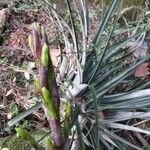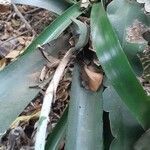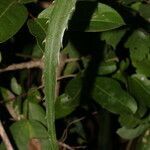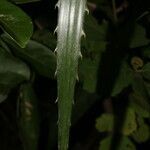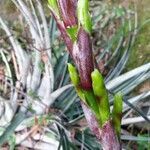Rosette up to 3 m. in diameter. Leaf-sheaths large, covered with long coarse dark brown scales; blades 3-5 cm. wide, acuminate, pungent, minutely lepidote beneath, laxly armed with coarse curved teeth 5-8 mm. long. Inflorescence many-flowered, flat-topped, surrounded by the red inner leaves. Primary bracts foli-aceous. Floral bracts narrowly oblanceolate, attaining the middle of the sepals, entire or sparsely serrate, membranaceous, coarsely lepidote. Flowers 6-9 cm. long. Pedicels short, stout. Sepals lanceolate, acute, lepidote, 3 cm. long. Petals narrowly lanceolate, to 4 cm. long, connate for more than 2 cm., glabrous, rose with white base and margins. Ovary lepidote. Berry fusi-form, 8 cm. long, 2 cm. thick, acid, edible.
More
A herb without a stem. The leaves form tufts. The clump can be 3 m across. The leaf blades are 3-5 cm across. At flowering the inner leaves become bright red. The flower stalk arises from the centre of the ring of leaves and the flowers are purplish-pink with white bracts. The fruit are yellow berries shaped like bananas. They are 8 cm long by 2 cm across. They form a clump but are not joined. The pulp has black seeds.
Marginal forests bordering savannahs and in deciduous forests, at elevations of 1,300-1,500 metres.
More
It is a tropical plant. It grows in forests near the edge of savannas.
